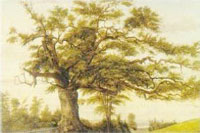Small Planet Communications, Inc. + 15 Union Street, Lawrence, MA 01840 + (978) 794-2201 + Contact







When the first Europeans arrived in present-day Connecticut, Algonquian-speaking Indians inhabited the area. The Pequot were the most powerful of the American Indian groups in Connecticut. They lived in the east and along the shore of Long Island Sound, an area they had taken from other native groups at the end of the 1500s. Early in the 1600s, a group of Pequots led by a chief named Uncas split off, named themselves Mohegan, and settled near the Thames River. Other American Indian groups in the area included the Niantic and Quinnipiac.
Dutch navigator Adriaen Block journeyed to the Connecticut River in 1614 and claimed the region as part of New Netherland. The Dutch set up a prosperous fur trade with the native inhabitants. In 1632 Edward Winslow of Plymouth explored the fertile river valley. Interest in fur trading increased following his reports of lush meadows along the river. The next year, Roger Ludlow led colonists from Dorchester, Massachusetts, in establishing a trading post and stockade near the site of present-day Windsor, Connecticut.
Learn more about Adriaen
Block and the exploration of
Connecticut (includes a map).

Read a biography of
John Winthrop, Jr.
By 1636 several groups had emigrated from the Plymouth and Massachusetts Bay colonies. John Winthrop, Jr., the son of the Massachusetts governor, founded Saybrook at the mouth of the Connecticut River. English trader John Oldham led a group from Watertown to settle Wethersfield. Minister Thomas Hooker led his congregation to Connecticut due to political and religious differences with the leaders of Massachusetts Bay. They founded the town of Hartford. Many American Indian groups were friendly toward the colonists, with the exception of the Pequots. After John Oldham was murdered off the coast of Block Island, friction between the Pequots and the settlers escalated into New England's first major conflict—the Pequot War (1637).
Since there were several claimants to the lands in Connecticut, Massachusetts Bay arbitrated among the different groups. Eight persons were nominated to be magistrates, with John Winthrop, Jr., acting as governor until a more permanent arrangement could be devised.
Read the Fundamental
Orders of 1639.
In the summer of 1638, representatives from the three principal towns of Hartford, Windsor, and Wethersfield met in Hartford to discuss plans to combine the settlements into a single colony. In 1639, Connecticut adopted what came to be known as the Fundamental Orders, a constitution based on democratic principles. Roger Ludlow, a trained lawyer, is credited with the final drafting of the Fundamental Orders. In 1639, he founded the settlement of Fairfield and served for many years as a magistrate and deputy governor of Connecticut.
Settlements continued to spring up elsewhere. In 1638 the Reverend John Davenport and Theophilus Eaton along with 500 English settlers established New Haven after purchasing a tract of land from the Quinnipiacs. The weakened Quinnipiacs agreed to sell the land in exchange for creating a military alliance with the settlers. Later settlements at Milford, Stamford, Guilford, Branford, and Southold joined New Haven to form the New Haven colony. The Davenport-Eaton company adopted strict laws regulating the religious and moral life of the colonists that were nearly identical to those of Massachusetts Bay.
Neither Connecticut nor New Haven was self-sufficient economically, and the two colonies engaged in trade with each other from the start. They remained separate entities except briefly in 1643, when Connecticut and New Haven joined with Massachusetts Bay and Plymouth in a mutual defense pact known as the New England Confederation.
In 1662 John Winthrop, Jr., governor of the Connecticut Colony since 1657, obtained a royal charter from King Charles II that gave the colony considerable self-government and control of New Haven Colony. The New Haven colonists protested their incorporation into the more liberal Connecticut until 1665 when they reluctantly agreed to the merge.
DID YOU KNOW?
The Charter Oak appears on
the back of Connecticut's 1999
commemorative state quarter.
Click to learn more about
the history of Connecticut.
Read a list of Connecticut's
historical firsts, including the
first hamburger served, the
first Frisbee, and the first
lollipop.
In the fall of 1687, King Charles II's successor, James II, attempted to organize New England under one government under the administration of Sir Edmund Andros. When Andros arrived in Hartford to demand the surrender of Connecticut's charter, the colonists resisted, and the document mysteriously disappeared. The colonists are thought to have hidden the document in the hollow of a large oak tree in Hartford, which became known as the Charter Oak. Although Andros was unable to secure the charter, he ruled Connecticut as part of New England until William and Mary replaced King James II in 1689. At that time, Andros was arrested, and colonial self-government was reinstated.
Connecticut | Bibliography
- AmericanTowns.com. "Town of Fairfield." Accessed 6/6/19. http://www.americantowns.com/ct/fairfield/organization/town_of_fairfield
- Atwater, Edward E. History of the Colony of New Haven to its Absorption into Connecticut. Quinnipiac University. Accessed 6/6/19. https://books.google.com/books?id=omW7vnDOcEwC&printsec=frontcover&source=gbs_ge_summary_r&cad=0#v=onepage&q&f=false
- Chronicles of America. "Connecticut." Accessed 6/6/19. http://www.chroniclesofamerica.com/pilgrims-puritans/connecticut.htm
- Connecticut State Library. "Connecticut Constitutional History, 1636–1776." Accessed 6/6/19. http://www.ctstatelibrary.org/pages/connecticut-constitutional-history/connecticut-constitutional-history
- Connecticut State Library. "Connecticut Colonial and Early State Records." Accessed 6/6/19. https://libguides.ctstatelibrary.org/hg/colonialresearch
- Connecticut State Library. "John Winthrop, Jr." Accessed 6/6/19. https://ctstatelibrary.org/wp-content/uploads/2015/05/John-Winthrop-Jr..pdf
- Dorchester Atheneum. "Roger Ludlow." Accessed 6/6/19. http://www.dorchesteratheneum.org/page.php?id=108
- Dow, Joseph. History of the Town of Hampton, New Hampshire: From Its Settlement in 1638, to the Autumn of 1892. "Sir Edmund Andros, Governor of All New England." Accessed 6/6/19. http://www.hampton.lib.nh.us/hampton/
HISTORY/dow/chap5/dow5_15.htm - Encyclopædia Britannica. "New Haven." Accessed 6/6/19. http://www.britannica.com/EBchecked/topic/411623/New-Haven
- Encyclopædia Britannica. "Pequot." Accessed 6/6/19. http://www.britannica.com/EBchecked/topic/450942/Pequot
- Encyclopedia of World Biography. "Edward Winslow." 2004. Encyclopedia.com. Accessed 6/6/19. http://www.encyclopedia.com/topic/Edward_Winslow.aspx
- Infoplease. "New England Confederation." Accessed 6/6/19. http://www.infoplease.com/encyclopedia/history/new-england-confederation.html
- Mashantucket Pequot Tribal Nation. "Tribal History." Accessed 6/6/19. http://www.mashantucket.com/tribalhistory.aspx
- The Mohegan Tribe. "Uncas, Sachem and Statesman." Accessed 6/6/19. http://www.mohegan.nsn.us/heritage/SachemUncas.aspx
- Montauk Friends of Olmsted Parks, Inc. "Liberty attached to the land...The Colony of Connecticut." Accessed 6/6/19. http://www.montauk.com/history/history.htm
- The Society of Colonial Wars in the State of Connecticut. "1633—House of Hope." Accessed 6/6/19. http://www.colonialwarsct.org/1633.htm
- The Society of Colonial Wars in the State of Connecticut. "1634—Wethersfield." Accessed 6/6/19. http://www.colonialwarsct.org/1634.htm
- The Society of Colonial Wars in the State of Connecticut. "1638—Colonists from Massachusetts Meet the Quinnipiac Indians." Accessed 6/6/19. http://www.colonialwarsct.org/1638_quinnipiac_indians.htm
- The Society of Colonial Wars in the State of Connecticut. "1639—Fundamental Orders." Accessed 6/6/19. http://www.colonialwarsct.org/1639.htm
- State of Connecticut. "Early Connecticut History." Accessed 6/6/19. http://www.kids.ct.gov/kids/cwp/view.asp?a=2573&q=329084
- Wade, Sheila. "Leaving England and Coming to New Haven with John Davenport." Yale-New Haven Teachers Institute. Accessed 6/6/19. http://www.yale.edu/ynhti/curriculum/units/2003/2/03.02.08.x.html
Connecticut | Image Credits
- Connecticut and New Haven Colonies, 1635–1660 | Adams, James T., Ed. Atlas of American History. New York: Charles Scribner's Sons, 1943. (p. 17)
- John Winthrop, Jr. | Artist: George F. Wright; Museum of Connecticut History
- Charter Oak | Artist: Charles De Wolf Brownell Connecticut History.org
© 2020 Small Planet Communications, Inc. + Terms/Conditions + 15 Union Street, Lawrence, MA 01840 + (978) 794-2201 + planet@smplanet.com



